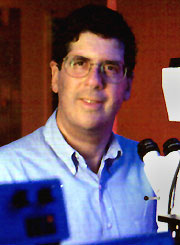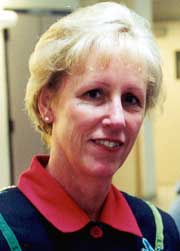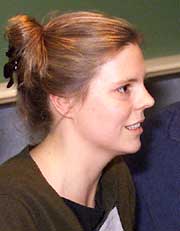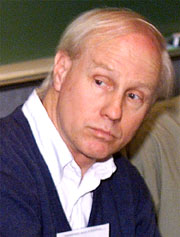Science Talk:
“What are the Challenges in Science Education—Now
and in the Future?”
Last week, 125 middle and high school teachers gathered
on the The Scripps Research Institute (TSRI) campus to attend
an all-day symposium, "Contemporary Issues in Bioscience,"
sponsored by TSRI in conjunction with the San Diego City Schools’
Partnerships in Education Program. Topics included the latest
developments in current basic biomedical research, the skills
required for a scientific career, and ways to encourage students
to further their education in science.
In the wake of this event, News&Views asked 11 individuals
from TSRI and beyond, "What are the challenges in science
education—now and in the future?"
|
 Martin Friedlander
Martin Friedlander
TSRI associate professor of cell biology
The key is educating the public. The better educated
people are about science and the process of discovery,
the more comfortable they will feel about science. A
good way to do this is to start with school age kids
and school teachers, making them enthusiastic about
science. I believe the teachers are extraordinarily
important in this regard; while I can have one or two
summer students in my lab each year, one teacher can
reach hundreds of students. If the teacher is passionate
about the subject matter, the students sense this and
become much more involved.
|
|
 Kim
Bess Kim
Bess
Director of science, San Diego City Schools
Probably the number one problem is that we have way
too many topics in our science course of study in the
United States. We also have topics that are being introduced
at age levels that are probably inappropriate. If you
look at nations that are outperforming our American
students, they do things in depth rather than breadth.
We’re known for breadth.
The second problem is that teachers in science initially
teach how they were taught at university, because that’s
their model. Most teachers in K-8 do not have a science
degree. They take a required course or two of study
in college, and these courses are delivered by graduate
students or teaching assistants in an amphitheater with
400 students. In their teacher preparation they’re
only given six to eight weeks of a science methods course,
then they enter the classroom. So they revert to the
habit of the last science instruction method they had,
which was a lecture.
The articulation of science is all over the place
from school to school. Somebody calls a course "integrated
science" and means one thing; somebody else calls a
course "earth science" and means another thing. So kids
are getting a lot of things retaught but not necessarily
learned. There has to be an experience that is more
meaningful.
What we know about how young children learn science
is that they learn by experiencing science. If they
don’t have those experiences imbedded early, by
the time they get to middle school, they pretty much
hate science. Then you get to high school where you
have such a depersonalization problem. A high school
teacher sees hundreds of kids. They’re lucky if
they remember their names. If you’re running five
sections with 34 or 35 bio or chem kids, you’re
on a treadmill. You’re on a treadmill.
The professional development that is needed to change
that is enormous. We have very little financial support
for science education. If you look around the nation,
especially at California, the governor’s initiatives
are all about language arts and mathematics, which is
terrific. But if you read the Glen Commission report
before it’s too late, there’s a critical economic
factor associated with not improving science education
in K–12.
|
|
 Bill
Miller Bill
Miller
Eighth grade science teacher at Lewis Middle
School
My class is a combination of all content areas put
together at one time—physical and earth all at
once. There are two pertinent points I see in the science
classroom in trying to get across some science instruction
that really has some teeth to it.
One is the class size. Having anywhere between 34
and 40 students in a class—and five sections a
day—is difficult. And having that many 13 and 14
year olds together in a classroom is very difficult.
Incorporating some sort of lab setting with that many
students at different stations in a limited size classroom
is not beneficial.
Second is lack of funding. To be able to even come
close to a microcosm of what they do here in the labs
at the public school level isÉ I mean, we have trouble
even coming up with glassware. Even coming up with basic
chemicals to do basic reactions is sometimes a huge
hurdle that we can’t seem to get over.
|
|
 M.
Elizabeth Stroupe M.
Elizabeth Stroupe
TSRI graduate student
As technology gets more advanced, one needs more information
to make sense of the developments. This challenges teachers,
then, to present the pertinent information without distilling
away the interesting part (experimentation, discovery,
failure...). The ultimate goal is to equip students
with skills to be informed citizens who can make intelligent
decisions. By piquing the students' interest in chemistry,
biology, math, and physics, we hope that even if they
do not chose a career in science, they will keep abreast
of scientific discoveries after their formal education
ends.
|
 Steve
Bartram Steve
Bartram
Marine science and biotechnology teacher, Rancho
Buena Vista High School
I got into a discussion a number of years ago with
a friend of mine who mentioned going to Israel. He said,
if you’ve been there for a few days you could write
a book. But if you’ve been there a month, you could
only write a story. And if you’ve been there six
months, you could then write one page.
As you begin to get more and more into this idea of
education, it’s the same way. A person who takes
a quick, big-picture glance at it would say, "I can
fix it. This is the way."
The problem is that it’s unbelievably difficult
to pinpoint any one thing. It takes many things together.
We need to reduce class size, increase the amount of
time the teacher has to prepare, make it so kids are
held accountable, give them the proper setting and the
security and everything else, take away all of the family
structure that is given to schools, and reinforce [science
education] at home—plus the labwork, plus all these
things. Then on top of that, teach them how to write
complete sentences, to be engrossed and enthusiastic,
and to WONDER what’s out there all at the same
time. And do it so that they can pass the high school
exit exams.
Make it so that the teacher doesn’t have to belong
to eight committees, so that they have time to be involved
with wonderful things like this, and so that they don’t
feel stretched.
It can’t all be done at once. For me personally,
reduce my class size, give me more preparation time.
[With so many students,] you hate to admit it, but it
may take you six to eight weeks to learn all their names.
|
1 | 2 |

|
|

